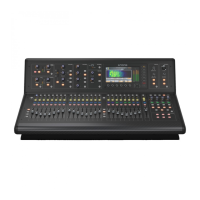92 M32 - Digital Console User Manual 93
Suboctaver
The Octave Eect combines the input signal with a digitally synthesised sound one or two octaves below the original
signal. This can be used to thicken up guitar sounds, or to add extra ‘punch’ to kick drums.
The controls for the Suboctaver are split between two discreet layers. Pressing the rst rotary control toggles the eect for
each layer on or o. The second control increases the amount of the aected signal that is present in the output mix. The
third control switches the range of the signal between LO, MID and HI. The fourth and fth controls adjust the level for
each of the individual lower octaves. To navigate between the two layers, use the up and down navigational controls.
Tremolo / Panner
Stereo Tremolo creates an up and down volume change at a constant and even tempo just like the guitar amps of yester-
year. Use the M32’s Stereo Tremolo to add a unique ‘surf-music’ texture to a vocal or instrumental track.
SPEED adjusts the LFO rate, and DEPTH sets the amount of modulation. PHASE can be used to set an LFO phase dier-
ence between the left and right channels, which can be used for panning eects. The WAVE rotary control blends the LFO
waveform between triangular and square shapes. The signal envelope , shaped by ATTACK, HOLD and RELEASE, can be
used to modulate the LFO speed (ENV SPD) and the LFO modulation depth (ENV DPTH).
Delay + Chamber
Here we have combined Delay and Chamber reverb, so that a single device can supply a variety of delay settings, plus add
just the right amount of reverb to the selected signal. This device only uses one eects slot. Inspired by the Lexicon PCM 70.
Use the BALANCE rotary control to adjust the ration between delay and reverb. Low frequencies can be excluded with
the LO CUT rotary control, and MIX adjust how much of the eect is added to the output signal. The TIME rotary control
adjusts the delay time for the left channel delay, and PATTERN sets the delay ratio for the right channel delay. Adjust the
FEEDBACK and trim some high frequencies with the FEED HC (high-cut) rotary control. The XFEED rotary control allows
you to send the delay sound to the reverb eect, so instead of running completely parallel, the reverb aects the echoes
to a selected degree. The PREDELAY rotary control determines the delay before the reverb aects the signal. The DECAY
rotary control adjusts how quickly the reverb fades. SIZE controls how large or small the simulated space (room, cathedral,
etc.). The DAMPING rotary control determines the decay of high frequencies within the reverb tail.
Chorus + Chamber
Taking up only one FX slot, the Chorus + Chamber eect combines the shimmer and doubling characteristics of a stu-
dio-grade chorus with the sweet sound of a traditional chamber reverb. Inspired by the Lexicon PCM 70.
The BALANCE rotary control adjusts the balance between chorus and reverb. Low frequencies can be excluded with the LO
CUT rotary control, and the MIX rotary control adjusts how much of the eect is added to the signal. SPEED, DELAY and
DEPTH adjust the rate, delay and modulation depth of the chorus. The LFO PHASE between the left and right channels
can be oset by up to 180°, and WAVE adjusts the LFO waveform from a sine wave to a triangular wave. The PREDELAY
rotary control determines the delay before the reverb aects the signal. The DECAY rotary control adjusts how quickly the
reverb fades. SIZE controls the size of the simulated space (room, cathedral, etc.). The DAMPING rotary control determines
the decay of high frequencies within the reverb tail.
www.theaudiospecialists.eu

